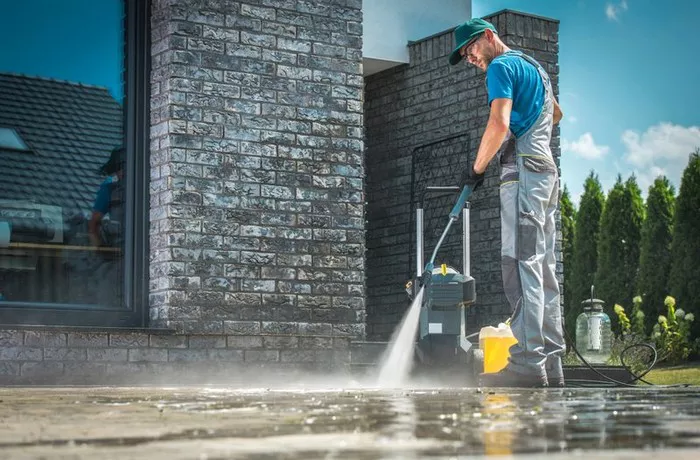Power washing, a commonly used method for cleaning exterior surfaces, can be highly effective in removing dirt, grime, and stains from concrete surfaces. However, it is crucial to understand that if not done properly, power washing has the potential to cause damage. In this comprehensive guide, we will delve into the intricacies of power washing and its impact on concrete surfaces, providing detailed insights to ensure the longevity and integrity of your concrete surfaces.
Understanding Power Washing
Power washing involves the use of high-pressure water to clean various surfaces, including driveways, sidewalks, patios, and walls. The equipment typically consists of a motorized pump that pressurizes water and a nozzle that directs the high-pressure stream onto the surface to be cleaned. The force of the water stream effectively dislodges dirt, grime, and other contaminants, restoring the appearance of the surface.
Potential for Damage
While power washing can effectively clean concrete surfaces, it is essential to recognize that certain factors can contribute to damage:
1. Excessive Pressure:
Using excessive pressure during power washing can pose a significant risk to concrete surfaces. High-pressure streams can erode the surface of the concrete, leading to pitting, spalling, or even cracking. It is crucial to adjust the pressure settings based on the condition of the concrete and the type of surface being cleaned.
2. Improper Technique:
Incorrectly angling the nozzle or holding it too close to the surface can concentrate the water stream in one area, causing etching or gouging. Conversely, moving the nozzle too quickly may result in ineffective cleaning, while moving too slowly can cause damage. Maintaining a proper distance and angle is essential to ensure even cleaning without causing harm.
3. Chemical Damage:
Some cleaning solutions used in conjunction with power washing can be harsh and may react adversely with concrete. These chemicals can cause discoloration, staining, or even weaken the surface of the concrete. It is crucial to use cleaning solutions that are specifically formulated for use on concrete and to follow manufacturer recommendations for dilution and application.
4. Aging or Weak Concrete:
Older or structurally compromised concrete is more susceptible to damage from power washing. The surface may already be weakened due to factors such as weathering, erosion, or underlying structural issues. In such cases, gentler cleaning methods may be more appropriate to avoid exacerbating existing problems.
Preventing Damage
To minimize the risk of damage when power washing concrete surfaces, consider the following precautions:
1. Adjust Pressure Settings:
Begin with the lowest pressure setting and gradually increase as needed. Avoid exceeding the recommended pressure for the specific surface being cleaned. Using a pressure washer with adjustable pressure settings allows for greater control and flexibility.
2. Maintain Proper Distance:
Keep the nozzle at least 6 to 12 inches away from the surface and maintain a consistent distance throughout the cleaning process. Holding the nozzle too close can concentrate the water stream and cause damage, while holding it too far may result in ineffective cleaning.
3. Use Suitable Nozzle and Techniques:
Select a nozzle that disperses water evenly and choose an appropriate spray pattern for the task at hand. A wide-angle nozzle is generally recommended for cleaning concrete surfaces, as it provides uniform coverage without exerting excessive pressure on the surface. Use sweeping motions rather than focusing on one spot for too long to avoid causing damage.
4. Test in a Small Area:
Before proceeding with full-scale cleaning, test the power washer on a small, inconspicuous area to assess its impact on the concrete surface. This allows you to determine the optimal pressure, distance, and technique for cleaning without risking damage to the entire surface.
5. Limit Chemical Usage:
If using cleaning solutions, ensure they are compatible with concrete and follow manufacturer recommendations for dilution and application. Avoid using harsh chemicals or bleach-based cleaners unless specifically recommended for use on concrete. In many cases, plain water and mechanical action from the power washer are sufficient to achieve satisfactory results.
Conclusion
In conclusion, while power washing can be an effective method for cleaning concrete surfaces, it is not without its risks. Understanding the factors that contribute to damage and implementing proper techniques and precautions are essential for preserving the cleanliness and integrity of your concrete surfaces. By adjusting pressure settings, maintaining proper distance, using suitable nozzles and techniques, testing in small areas, and limiting chemical usage, you can minimize the risk of damage and ensure the longevity of your concrete surfaces.
FAQs
Q1. Can power washing remove oil stains from concrete?
A1: Yes, power washing can effectively remove oil stains from concrete surfaces. However, depending on the severity of the stain and the type of oil, additional cleaning agents or techniques may be necessary for complete removal. It is recommended to pretreat oil stains with a degreaser before power washing for optimal results.
Q2. How often should I power wash my concrete driveway?
A2: The frequency of power washing your concrete driveway depends on various factors such as climate, level of usage, and presence of debris. As a general guideline, consider power washing your driveway annually or as needed to maintain its cleanliness and appearance. However, in areas with heavy traffic or frequent exposure to dirt and grime, more frequent cleaning may be necessary.
Q3. Can power washing cause mold or mildew to spread on concrete surfaces?
A3: While power washing can remove existing mold or mildew from concrete, if not done properly, it can potentially spread spores to other areas. To prevent this, use appropriate cleaning solutions designed to inhibit mold and mildew growth and ensure thorough rinsing after power washing. Additionally, consider applying a sealant to the cleaned surface to provide long-term protection against mold and mildew growth. Regular maintenance and proper cleaning techniques can help prevent the spread of mold and mildew on concrete surfaces.

